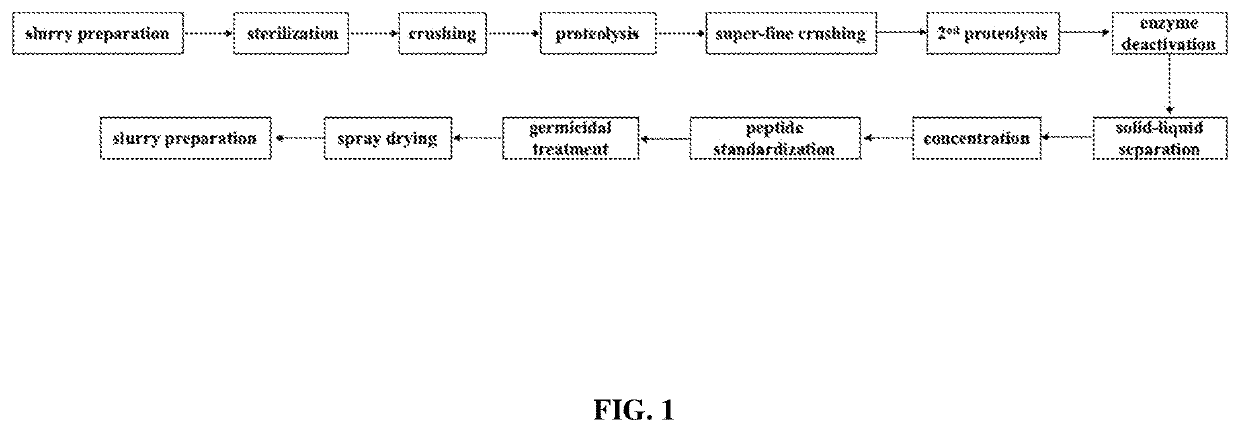Methods for producing a rice protein peptide and applications thereof
a technology of rice protein and peptide, which is applied in the field of rice products, can solve the problems of poor solubility, water retention and foaming of rice protein, severely limit the application range of rice protein, and low nutritional value and value-added of rice protein products, and achieve the effect of promoting the proteolytic efficiency and tas
- Summary
- Abstract
- Description
- Claims
- Application Information
AI Technical Summary
Benefits of technology
Problems solved by technology
Method used
Image
Examples
example 1
[0035]There is provided a method for producing a rice protein peptide including the following steps:
[0036](1) preparing 5% of rice residue protein slurry, followed by sterilizing the rice residue protein slurry at 135° C. for a reaction time of 5 seconds to obtain a material;
[0037](2) crushing the material from step (1) to 600 mesh by using a colloid mill to obtain a crushed rice residue protein, where a D50 particle size distribution of the material is reduced to 30 microns;
[0038](3) adding 5% of alkaline protease for undergoing a first proteolysis after adjusting the temperature of the rice residue protein from step (2) to 60° C. and the pH value to 12.0, where the proteolysis process is performed at 60° C. for a reaction time of 5 hours;
[0039](4) performing super-fine grinding on the proteolytic rice residue protein by using a micro jet to obtain a first proteolytic fluid, where a D50 particle size distribution of the crushed material is 5 microns;
[0040](5) adding 5% of neutral p...
example 2
[0049]There is provided a method for producing a rice protein peptide including the following steps:
[0050](1) preparing 5% of rice residue protein slurry, followed by sterilizing the rice residue protein slurry at 100° C. for a reaction time of 30 minutes to obtain a material;
[0051](2) crushing the material from step (1) by using a fine crusher to obtain a crushed rice residue protein, where a D50 particle size distribution of the material is reduced to 30 microns;
[0052](3) adding 0.3% of alkaline protease for undergoing a first proteolysis for a reaction time of 1 hour after adjusting the temperature of the rice residue protein from step (2) to 45° C. and the pH value to 9.0;
[0053](4) performing super-fine crushing on the proteolytic rice residue protein by using a ball mill to obtain a first proteolytic fluid, where a D50 particle size distribution of the crushed material is 10 microns;
[0054](5) adding 0.3% of neutral protease for undergoing a second proteolysis for a reaction tim...
example 3
[0063]There is provided a method for producing a rice protein peptide including the following steps:
[0064](1) preparing 5% of rice residue protein slurry, followed by sterilizing the rice residue protein slurry at 115° C. for a reaction time of 15 minutes to obtain a material;
[0065](2) crushing the material from step (1) by using a high-speed blender to obtain a crushed rice residue protein, where a D50 particle size distribution of the material is reduced to 40 microns;
[0066](3) adding 1% of alkaline protease for undergoing a first proteolysis after adjusting the temperature of the rice residue protein from step (2) to 55° C. and the pH value to 10.5, where the proteolysis process is performed at 55° C. for a reaction time of 3 hours;
[0067](4) performing super-fine grinding on the proteolytic rice residue protein by using a mechanical impact pulverizer to obtain a first proteolytic fluid, where a D50 particle size distribution of the crushed material is 8 microns;
[0068](5) adding 2...
PUM
| Property | Measurement | Unit |
|---|---|---|
| Temperature | aaaaa | aaaaa |
| Temperature | aaaaa | aaaaa |
| Temperature | aaaaa | aaaaa |
Abstract
Description
Claims
Application Information
 Login to View More
Login to View More - R&D
- Intellectual Property
- Life Sciences
- Materials
- Tech Scout
- Unparalleled Data Quality
- Higher Quality Content
- 60% Fewer Hallucinations
Browse by: Latest US Patents, China's latest patents, Technical Efficacy Thesaurus, Application Domain, Technology Topic, Popular Technical Reports.
© 2025 PatSnap. All rights reserved.Legal|Privacy policy|Modern Slavery Act Transparency Statement|Sitemap|About US| Contact US: help@patsnap.com

